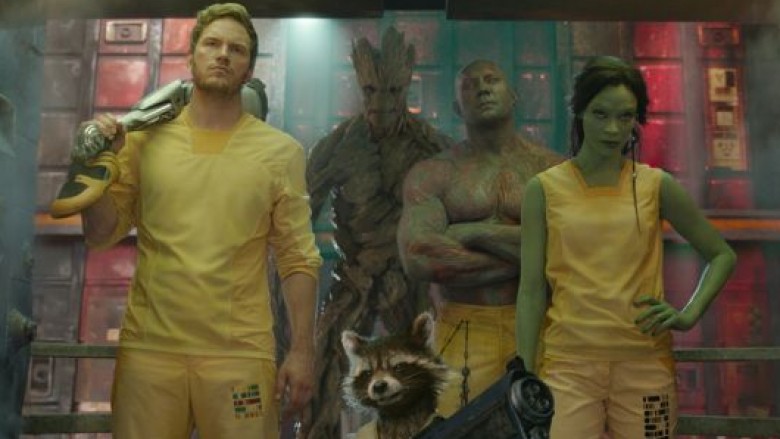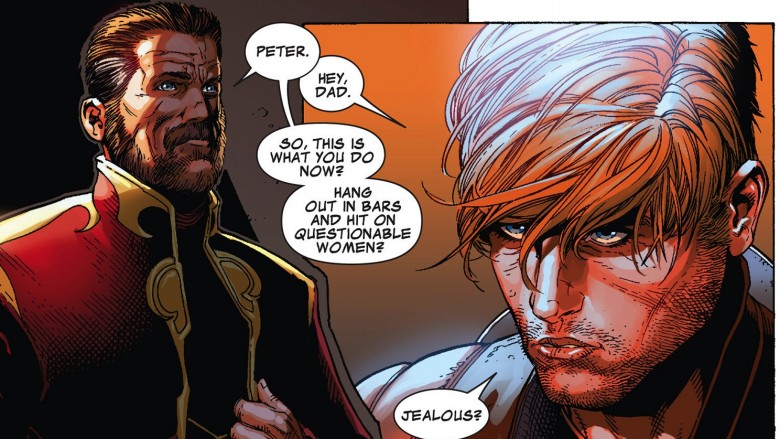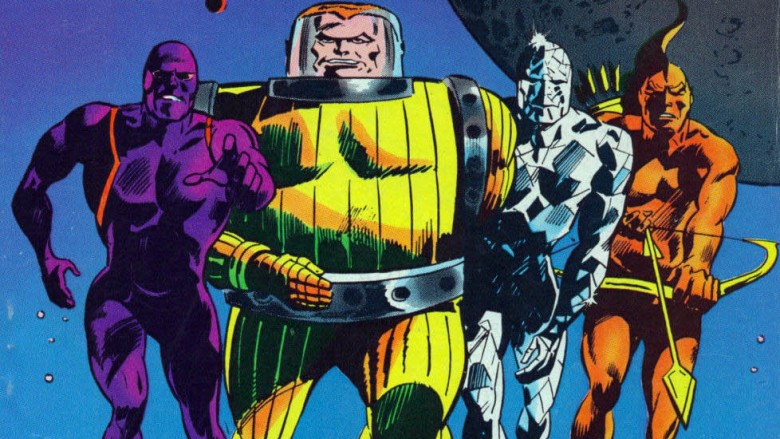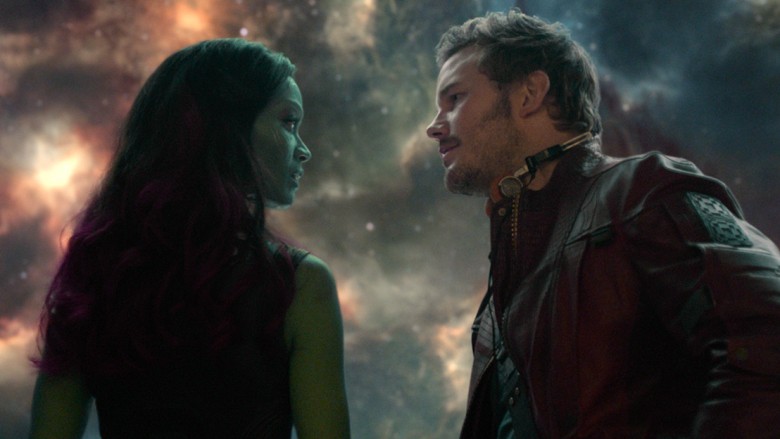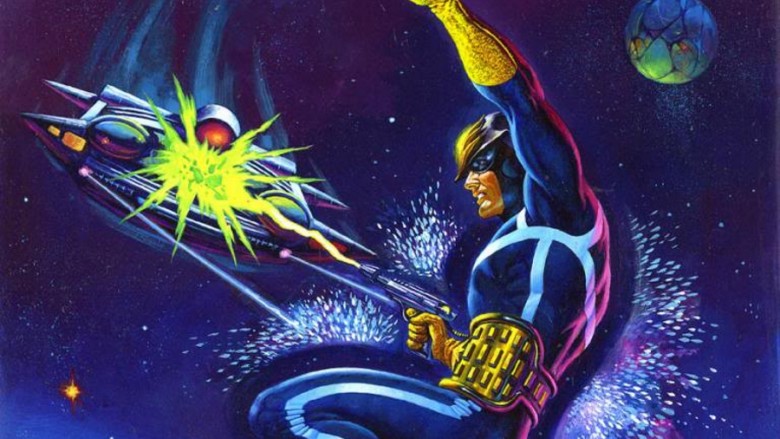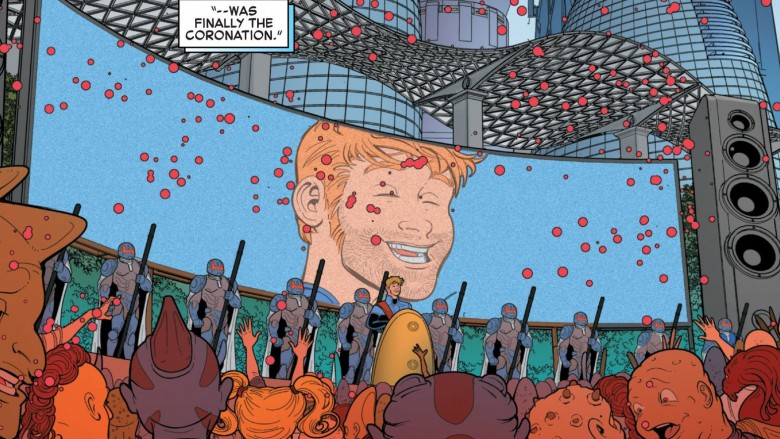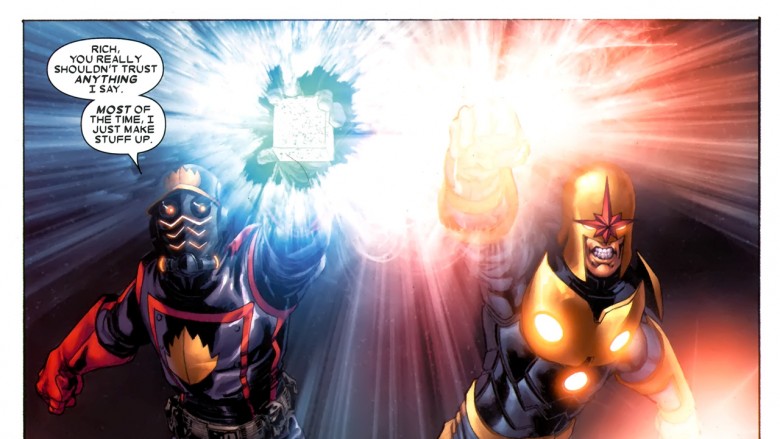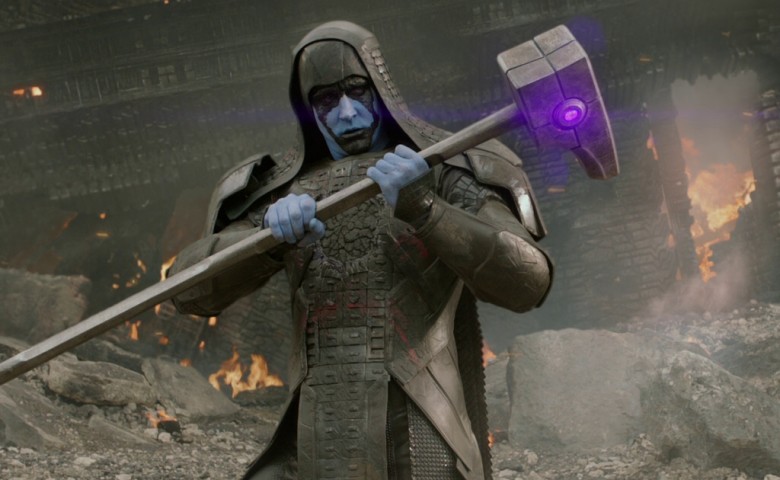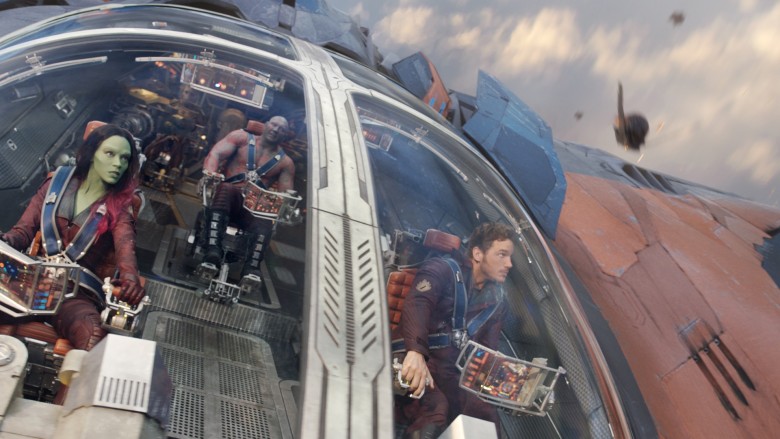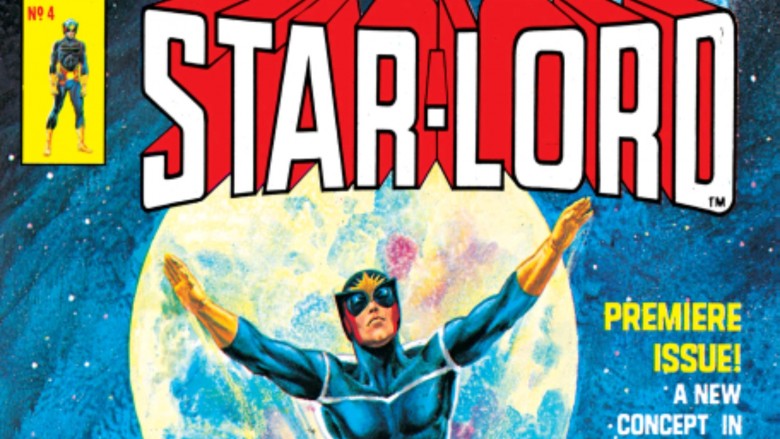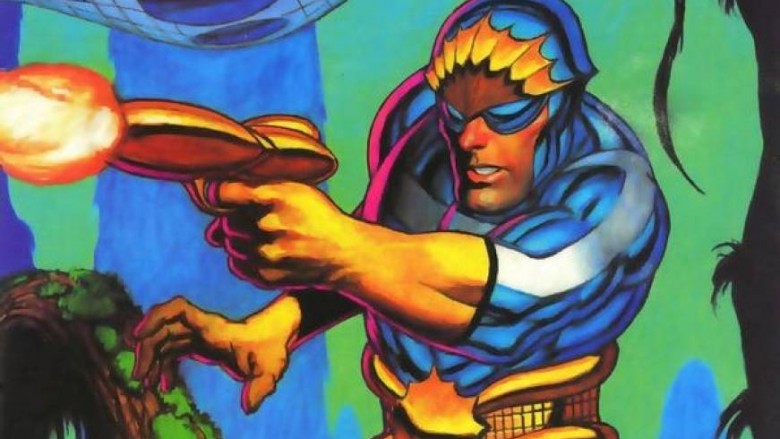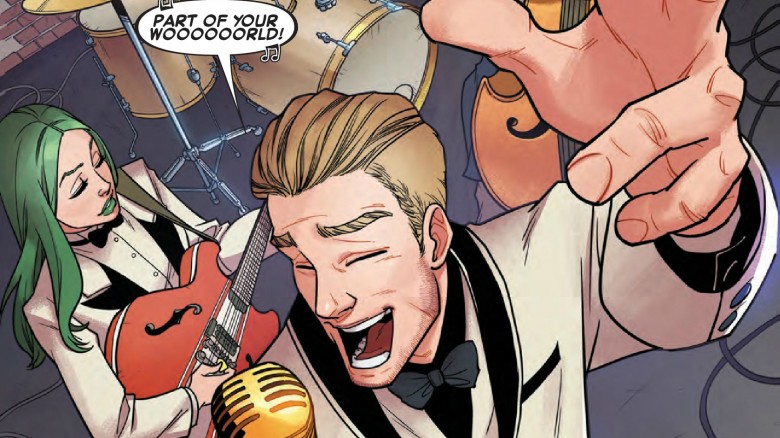What Comic Fans Know About Star-Lord That You Don't
We may receive a commission on purchases made from links.
Fans of Guardians of the Galaxy know one thing for sure: Peter Quill is a pretty gnarly dude. With a name like Star-Lord, it's pretty much a moral imperative to become a chew-bubblegum-and-kick-butt space adventurer. Quill is a quick-draw with an element gun and holds his own against Yondu's space pirates, militant Kree warlords, and even Mad Titans named Thanos, who like big chairs and upscale space bling. Nevertheless, there's much more to cosmic do-gooder Peter Quill than meets the 3-D glasses-tinged eye.
Star-Lord's nickname is somewhat ironic
A comic book character without a code name is no comic book character at all; at least, that's what conventional wisdom (and marketing) seem to be saying. Don't get us wrong — Tony Stark is a pretty cool-sounding name, but Iron Man is a much punchier—literally and figuratively—super-heroic name. However, like Tony's moniker, Barry Allen's zippy Flash, or Peter Parker's Spider-Man tag, their names also make a good deal of sense to their respective crime-fighting identities. Tony's exosuit is made from metal (or alloy), Allen is really fast, and Peter is a man infused with the radioactive gene of a spider.
In Star-Lord's case, however, his title doesn't make much sense initially. True, he's out there among the cosmos, but he certainly doesn't seem like much of a lord, unless prison yellow is the new royal look around the galaxy. Depending upon which origin story you go by, Star-Lord was either granted his title by the Master of the Sun — a moniker which he literally stole from a competitor — or, in his more recent incarnation, his title is actually an ironic jest upon the character's birthright. See, after Peter Quill leaves Earth in a stolen Kree ship, he later discovers that his father actually is a star lord named J'Son, ruler of Spartax. His father wants him to follow in his footsteps, and rule the Spartoi Empire as the Star-Lord, but Quill has no interest in galactic politics, conquest, or petty despotism. Parting on meh terms with pops, he shirks his royal duties, carrying on paradoxically as "Star-Lord" while he runs around the galaxy with the Guardians.
Star-Lord has 3 different origin stories
In the comic book world, few things are more important than a good origin story. Bruce Wayne has his parents murdered by thugs and decides to emulate the creatures of the night to become Cricket-, uh, Batman. Kal-El was launched from the dying world of Krypton to Earth and raised in Kansas, becoming the poorly concealed Clark Kent. So, like many superheroes, Peter Quill has a killer origin ... well, actually, three of them.
First drawn up in 1976 by Steve Englehart and Steve Gan in Marvel Preview #4, Peter started out very similar to Anakin Skywalker (or Jesus Christ, if you'd rather), as a seeming immaculate conception during an alignment of the planets. Apparently, Englehart was big into astrology, and gave him a birthdate of February 4, 1962 as the ultimate child of the Age of Aquarius. Soon thereafter, he discovers he's the illegitimate son of Jason (or J'Son), ruler of the planet Spartax, and a human mother named Meredith Quill. Peter's orphaned when an alien species (or a renegade band of his father's men, depending) kill his mother. Later, he becomes an astronaut and is either granted an intergalactic set of threads, or he joins the band of space pirates known as the Ravagers, before unlocking his royal birth.
His more-recent backstory was once again tweaked (and streamlined into official Marvel's official continuity in 2016), after Peter took to the silver screen in 2014. His Guardians of the Galaxy origin retains key elements of his current history, only changing a few things. This time around, his mother dies of cancer instead of being killed by the Badoon (who belongs to 20th Century Fox), and he was sired by a living planet named Ego (played by Kurt Russell. Hell yeah!). We're really looking forward to James Gunn's explanation about that one.
He wasn't originally one of Guardians of the Galaxy
As far as intergalactic do-gooders go, few can top the witty banter and charmingly offbeat derring-do of Marvel Cosmic's Guardians of the Galaxy, in all their tree-hugging (I am Groot), blue pirate butt-kicking, Infinity Stone-stealing glory. Heck, giving a foul-mouthed anthropomorphic raccoon the voice of Bradley Cooper was a stroke of genius alone. However, Rocket, Gamora, Groot, and Drax aren't charter members of the galactic squad. Even Star-Lord didn't sign up until much later on.
The Guardians initially launched way back in 1969. First strung together by Arnold Drake and Gene Colan, the initial team fought the good fight in the 31st century (and later, on the alternative Marvel timeline, Earth-691). The team was comprised of Major Vance Astro, an astronaut stuck in suspended animation for a millennia (Rip Van Winkle, eat your heart out); Martinex T'Naga, a creature made from crystal and hailing from Pluto; Captain Charlie-27, a Jupiterian—Jupiterite? Jupiteranian. Whatever—soldier; and blue-skinned Alpha Centauri IV-dweller, Yondu Udonta, whom fans will recognize as captain of the Guardians' big screen foes, the Ravagers.
After their late-'60s launch, the original lineup bounced around the cosmos for several decades, before being "retired" in 1995 due to lack of sales. The current line-up actually didn't come together until 2008, when modern Marvel Cosmic legends Dan Abnett and Andy Lanning (known as DnA) brought together the current incarnation of Star-Lord, Gamora, Groot, et. al.
Gamora and Peter aren't an item in the comics
Technically, Peter and Gamora don't get together in the first Guardians of the Galaxy. There certainly is a good bit of sexual tension between them, but nothing happens ... yet. Looking back to the source, though, Gamora and Peter Quill were never really much of an item in the pages of Marvel, either. Typically, Gamora had an on-again, off-again thing going with Richard Rider, the original Nova. Before she dated Rider, she also partook in a rocky romance with genetically modified super-being Adam Warlock, although after he went insane (yet again), he decided it might be best to stay into his cocoon.
Peter, on the other hand, bounced around the cosmos as a bit of an intergalactic bachelor during the early days. Before the first Guardians hit theaters, Star-Lord began an epic courtship with hardcore X-Men telepath Kitty Pryde. The mutant and the galactic wayfarer enjoyed a hot and heavy relationship, with the two nearly getting married before the buzzkill of Civil War II and the whole mutants-facing-death thing put a halt to their feels. At the moment, it appears Kitty's rejoined the X-Men, and their relationship seems a little frosty. Peter's still on Earth, however, so anything could happen.
As far as the Marvel Cinematic Universe goes, Peter and Kitty's relationship is somewhat impossible, in a Romeo and Juliet kind of way. Since she's a mutant, her character belongs to 20th Century Fox, while his property rights live at Disney—so their romance won't likely see the light of day on the big screen.
Star-Lord started life as a cosmic policeman in tights
Peter Quill wasn't always the wisecracking cosmic goofball brought to life by Chris Pratt in theaters everywhere. When first conceived and executed by Steve Englehart and Steve Gan, he was more of a jerky orphan who got hold of some mad cosmic skills. He initially donned a costume that looks like something of a cross between the intergalactic 5-0 and an un-caped crusader—which makes some sense, seeing as the Star-Lords was another form of cosmic cops.
Peter starts life rocking a mushroom-like army helmet and a uniform, complete with utility belt-looking thingy, which protects him to from the vacuum of space. It also allows him to fly, all while looking like a total fool. This incarnation of Pete also brought with it a rinky-dink version of the Element Gun, even if it was still capable of harnessing and controlling air, water, earth, and fire (but not heart) at will.
When writer Chris Claremont (of Uncanny X-Men fame) and artist John Byrne later took over, they ditched the mushroom-like helmet whenever possible, leaving Star-Lord with just a silly cowl. For his return in 2004, he got a major overhaul, and yet another update when he and Marvel Cosmic went to war with a bunch of power-hungry space bugs from the Negative Zone, during the "Annihilation" story line. At that point, his space uniform, complete with a nifty hypno-eyed space helmet, consistent with his more-recognizable look, began to take shape.
When adapting Star-Lord for the cinema, though, Marvel revamped his getup once again, giving Star-Lord more of a slacks, t-shirt, and a killer space ranger jacket affair—perfect for the casual space adventurer/son of a planet that he became.
He ruled an empire, for a little while
Peter Quill is about to have a planet for a father, which his pretty cool for sure. But his classic comic book padre ruled the entire Spartoi Empire. After uncovering his true patriarchal lineage, Peter was even "invited" by his father to stay on, learn the ropes, and do the interstellar debutante thing. Star-Lord, being a free spirit, impolitely declined his offer.
The second time around, he discovers that his father was deposed from Spartax and the people, inexplicably stuck in the monarchic lineage thing, elected him as their new king. After a series of misadventures—including that one time when the whole friggin' universe ended (the Secret Wars reboot)—Peter reluctantly decides to rule the empire after all. But there was a problem. A pair of nasty Kree warlords decided to hold him responsible for the destruction of an entire planet. Let's just say, things got rather messy. The Spartoi people decided they didn't care for Star-Lord's new wreck-our-planet-by-default direction, and Peter and the Guardians had to flee Spartax as wanted criminals. Good times!
He nearly died in a place called the Cancerverse
A few years before Guardians of the Galaxy first rolled in theaters, Peter Quill faced one of his toughest, and bleakest, challenges ever. A handful of cosmic cuckoos decided to open a rift (known as The Fault) to another universe where Death had lost to everlasting life. In this particularly bizarre place, known as the Cancerverse, every time you die, you just respawn, like some sort of disturbing comic book MMO game.
Apparently, however, living forever wasn't enough for these death-free folks. Nope, they decided to kill off Death in the regular Marvel Universe, so they could take over there as well. In order to do so, they had to kill Thanos. The only problem was, Death (the cosmic embodiment, anyway) decided to spite him with the inability to die. They really should have found some common ground there.
After failing to kill Thanos, the death-enabled members of Earth-616 called his star-crossed lover, Death—the ultimate "it's complicated" status update—to wipe out the life-enabled Cancerversians, which she did handily. However, Star-Lord, Richard Rider (Nova), and the un-fragged Drax the Destroyer decided to trap the perpetual pain-in-the-butt Thanos inside the alternative dimension. They almost succeeded in doing so, at the cost of their own lives. Fortunately, Nova managed to get his hands on a handy, universally potent Cosmic Cube, allowing everyone to escape ... including Thanos, ironically.
Star-Lord and the Kree have a pretty darn good relationship
Guardians introduced a number of new elements to the Marvel Universe. Among them was the presence of a particularly thuggish, blue-skinned baddie named Ronan the Accuser and his somewhat indifferent people, the Kree. While Ronan's people are, technically, not the team's enemies in the movie, they don't exactly come across as having a cozy relationship with the Guardians—as Star-Lord and his band side with the Nova Corps of Xandar, the Kree Empire really doesn't do much to stop their renegade former general.
The same can't be said for comic book Peter Quill and the galactic sovereignty. After the jerky, space bugs from the Negative Zone decimated the galaxy's forces during the "Annihilation Wave," Star-Lord helped the Kree rebuild their defense forces. Heck, despite a few disagreements, he and Ronan actually worked side-by-side on many occasions, including stopping James Spader — er, Ultron from infecting their home world of Hala with a technological virus.
Perhaps Star-Lord and the Kree will have a better working relationship in the future.
Star-Lord's original spaceship was sentient
As some fans of Guardians may know, the cosmic defenders cruise the space ways in a wicked little ship known as the Milano. According to director James Gunn, he christened the ubiquitous spacecraft after his childhood crush, Alicia Milano—one-time star of the sitcom Who's The Boss? But Star-Lord's spaceship originally started life in a very different way.
In the early days, before Peter Quill cruised the cosmos with the Guardians, his vessel simply went by the clever name of "Ship." Before Ship ferried Quill across the cosmos, though, she was once a sentient star named Aurora. Apparently, just as she was starting to make friends with the evolving species on the worlds she illuminated, some hot-shot alien scumbags turned her into a supernova, destroying her solar system. Yet her conscious lived on, and the first Star-Lord mentor, the Master of the Sun, hammered her self-awareness into a spaceship. At one point, Ship even developed a serious crush on Peter, creating a humanoid female form named Caryth Halyan. They even made out once, before her slinky bipedal form was destroyed, and she returned to vessel format. Talk about an awkward trip home.
In the present comic continuity, though, the Guardians' spacecraft was built by Rocket Raccoon and goes by the also-quick-witted name of C.I.T.T.—or Cool Interstellar Travel Travelship. C.I.T.T. also more closely resembles the Milano than Ship ever did.
His first solo comic is worth THOUSANDS of dollars
Certain comic books are worth a fortune—just not the ones with sixty different variants and chrome covers from the '90s, which contributed to the industry's near-collapse. Still, if you get your hands on a copy of Batman's first caper in Detective Comics #27 from 1939, you're looking at a cool million bucks at least. Even later-era comics with a larger print run, like Wolverine's first appearance in Giant Size X-Men #1, still bring a considerable amount from retailers and in auctions.
The same goes for Star-Lord's first appearance in Marvel Preview #4. Complete with his name lit up in red across the front, the limited availability of a truly mint-condition book can net collectors a cool grand or three. Of course, don't let your kid brother or sister leaf through that issue, or you'll have to settle for a cool hundred bucks. Still, a pair of hundos isn't a bad deal for a guy wearing black spandex and a utility belt.
There was another Star-Lord
Throughout the years, many characters have swapped monikers, or taken up the mantle of their fallen or disappeared comrades. For example, Bucky Barnes was only one of a dozen characters to take over the Captain America gig from Steve Rogers. Dick Grayson filled in as Batman during Bruce Wayne's "death." And Carol Danvers isn't the first Captain Marvel by a long shot.
Some characters like Star-Lord, on the other hand, have remained relatively legacy-character free throughout their comic book career. Relatively. During a brief stint in the mid-'90s, another character did take a spin in his name (and his vessel). For three whole issues of Starlord, Sinjin Quarrel, a psychic law enforcer who discovered Peter's living ship named "Ship," badly damaged and suffering from sentient vessel amnesia, took over the moniker. With Sinjin's aid, Ship recovers her memories, and helps him unlock the secrets to Star-Lord's nifty gear. During this time, Ship also gets a little backstory too, as her name is finally revealed as Aurora. At least it wasn't "Girl."
Peter becomes a lounge singer at the end of the world
In 2015, Marvel decided to start every single comic over with a relatively clean slate. The resulting event, known as the "Secret Wars," created a series of calamitous events, where every single world from within the Marvel multiverse essentially imploded. As the universe around them begins to collapse, archfiend Doctor Doom borrows some wicked cosmic powers and creates his own little kingdom at the end of the universe. His "Battleworld" is broken down into several fiefdoms, including the Kingdom of Manhattan.
Constructed inside the shell of Grand Central Station, Inhumans leader Black Bolt built a little superhero supper club called The Quiet Room. Not just a great place for knishes, the lounge was also secretly a meet-and-greet for the resistance. In an attempt to escape Emperor Doom's wrath, Star-Lord sets up as lounge singer in the club, calling himself Steve Rogers. To entertain esteemed guests and anti-Doom revolutionaries, he croons all the old Disney standards. Eventually, he gets back into the heroic swing of things—especially after he gets fired for some shenanigans—and helps Reed Richards take down the God Emperor.
In the days leading up to Marvel's universal reboot, though, Peter's rendition of The Little Mermaid's "Part of Your World" was an appropriately amusing tune.

